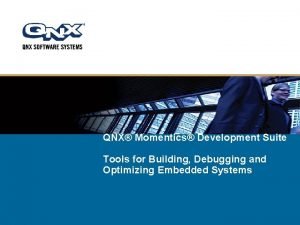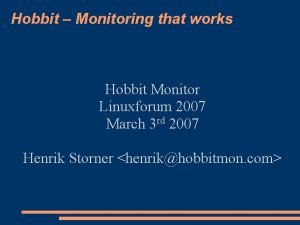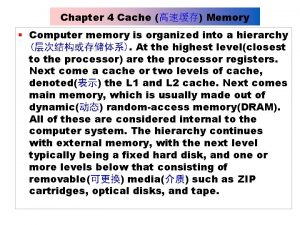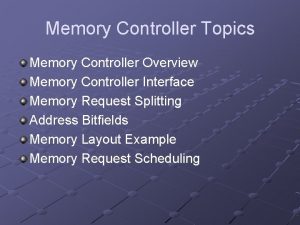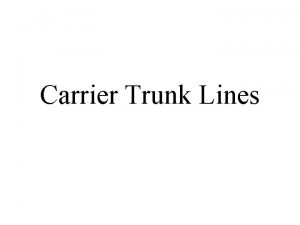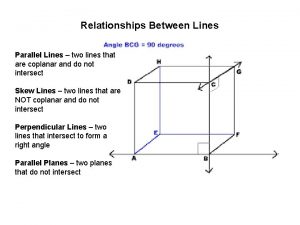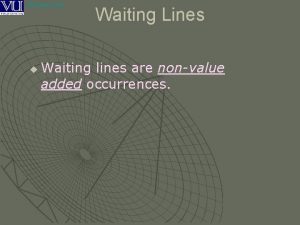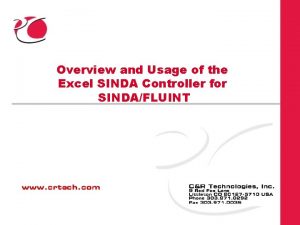The Memory Controller Overview ControlAddress Lines usage Memory























![Static Memory Controller OE* Output Enable SRAM Memory Devices WE* Write Enable BE[3: 0]* Static Memory Controller OE* Output Enable SRAM Memory Devices WE* Write Enable BE[3: 0]*](https://slidetodoc.com/presentation_image_h/02cac1483ef128f463ab4d294f49d904/image-24.jpg)


- Slides: 26

The Memory Controller Overview Control/Address Lines usage Memory Module Configuration Register settings Chip Select Base Address Register settings Device considerations

Memory Controller Overview BBUS 32 Bit Address Bus 32 Bit Data Bus NET+ARM Memory Controller 11 Direct Pins Bus Controller ADDRESS BUS • A 28 : A 0 CONTROL LINES • Chip Select • Write Enable • Output Enable • Byte Enables • RAS • CAS • 256 Mbytes / Chip Select • SRAM and DRAM Supported • A 13 : A 0 Multiplexed External Bus Master • Bus Request • Bus Grant • Busy DATA BUS • D 32 : D 0 • D 31 : D 24 8 Bit Device • D 31 : D 16 Bit Device • D 31 : D 0 32 Bit Device

Memory Controller Hardware Dependencies RESET* Low for 512 Clocks Followed By 1 usec pulse RESET Address Line Bootstrapping A 24 A 23 ADDR[24: 23] CS 0 Bootstrap Setting 00 Bootstrap Disabled 01 32 -Bit SRAM port; 15 wait states 10 32 -Bit DRAM port; 15 wait states 11 16 -Bit SRAM port; 15 wait states The firmware MUST match the bootstrap setting Internal pull up constant current sources on Address Bus

Memory Controller Memory Map Address FFC 0 0000 FFC 0 0014 FFC 0 0018 FFC 0 0020 FFC 0 0024 Address Range 0 x. FFC 0 0000 0 x. FFCF FFFF Module MEM Module FFC 0 0028 FFC 0 0030 FFC 0 0034 FFC 0 0038 FFC 0 0040 FFC 0 0044 FFC 0 0048 FFC 0 0050 FFC 0 0054 FFC 0 0058 Register MMCR Chip Select 0 BAR Chip Select 0 ORB Chip Select 1 BAR Chip Select 1 ORB Chip Select 2 BAR Chip Select 2 ORB Chip Select 3 BAR Chip Select 3 ORB Chip Select 4 BAR Chip Select 4 ORB

Memory Module Configuration Register (MMCR) FFC 0 0000 31 30 29 28 27 26 25 24 RFCNT 15 - 14 - 13 - 12 - 23 22 RCYC REFEN 11 - 10 - 9 - 8 - 7 - 21 6 - 5 - 20 19 18 17 16 AMUX A 27 A 26 A 25* AMUX 2 4 - 3 - 2 - 1 0 - - Chip Select Base Address Register (CSBAR) [ FFC 0 0010 FFC 0 0040 ] 31 30 29 28 27 26 25 24 23 22 21 20 19 18 17 16 6 5 4 3 2 1 0 BASE 15 14 13 12 BASE 11 10 9 PGSIZE 8 DMODE 7 DMUXS EXTTA DMUXM IDLE DRSEL BURST WP V Chip Select Option Register (CSOR) [ FFC 0 0014 FFC 0 0054 ] 31 30 29 28 27 26 25 24 23 22 21 20 19 18 17 16 6 5 4 3 2 1 0 MASK 15 14 13 MASK 12 11 10 9 WAIT 8 7 BCYC BSIZE PS WP V

MMCR RFCNT, REFEN, RCYC D 24 D 31 RFCNT Refresh Period = [ ( RFCNT + 1 ) * 4 ] / Fxtal Example: For a refresh period of 15. 191 usec, RFCNT must be 13. . Assuming Fxtal = 3. 6864 MHz D 23 REFEN Must be Set for DRAM Devices D 22: 21 RCYC Refresh Cycle Count 00 8 BCLK Clocks 01 6 BCLK Clocks 10 5 BCLK Clocks 11 4 BCLK Clocks NOTE: The NET+ARM DRAM Controller Always Generates CAS before RAS Refresh Cycles

MMCR AMUX External Multiplexer Logical Addresses Externally Multiplexed Addresses NET+ARM Address Pins Port. C 0 Port. C 1 Port. C 2 Port. C 3 / AMUX Port. C 4 / RIB* DRAM SEL RAS Address Driven CAS Address Driven D 20 PORTC 3 AMUX Lower Address Bits Upper Address Bits 0 Disable external Port. C 3 multiplexing 1 Enable external Port. C 3 multiplexing

MMCR AMUX 2 Internally Multiplexed Signals D 16 AMUX 2 0 Normal Operation 1 Drive Port. C 3 DRAM Multiplexing NET+ARM DRAM Addresses External BUS Master Port. C 0 Port. C 1 Port. C 2 Port. C 3 / AMUX Port. C 4 / RIB* DRAM SEL NOTES: RAS Address Driven CAS Address Driven PORTC 3 Lower Address Bits Upper Address Bits 1. 2. 3. 3. 4. External bus master must have the ability to multiplex RAS & addresses Inactive bus master must tri-state address bus Drives Port. C 3 Multiplexing Regardless of AMUX & DMUX

MMCR A 27, A 26 NET+ARM Conventional Method Special Case Method GND VCC ADDR 27/CS 0 OE* ADDR 26/CS 0 WE* OE* WE* CS 0* CS 1*/RAS 1* CS 2*/RAS 2* CS 3*/RAS 3* CS 4*/RAS 4* D 19 A 27 Enable A 27 Output 0 CSO 0 E* Driven 1 ADDR 27 Driven D 18 Ground WE* OE* CE* FLASH A 26 Enable A 26 Output 0 CSOWE* Driven 1 ADDR 26 Driven NET+ARM Note: When used as special function, peripheral cannot ‘need’ A 26 & A 27 OE* WE* CE* FLASH

MMCR A 25* as Input is Burst Terminate Signal GND VCC ADDR 27/CS 0 OE* ADDR 26/CS 0 WE* ADDR 25/BLAST* 0 1 A 23 Memory Peripheral (X 32) D 17 External BUS Master A 25* Enable A 25 Output 0 Used for Address Line 25 1 Used for BLAST* Signaling Note: When used as special function, peripheral cannot ‘need’ A 25 BLAST* Burst Continuance Last Cycle of Burst

CSAR BASE, PGSIZE, DMODE Sample NET+ARM Memory Space Physical Base Address of Peripheral D 31 D 12 BASE 0800 0000 0 x 00200 equates to 0 x 00200000 BASE must be consistent with the size of the MASK field in the Option Register • A 4 M device MUST reside on a 4 M Base Boundary FPGA D 11 Peripheral Page Size 0400 0000 D 10 PGSIZE 00 64 Bytes 01 32 Bytes 10 16 Bytes 11 8 Bytes FLASH 0200 0000 Page SDRAM 0000 D 9 D 8 DMODE 00 FP DRAM 01 EDO DRAM 10 Sync DRAM 11 RESERVED NOTE: ALL DRAM BANKS MUST HAVE THE SAME DMODE SETTING

CSAR DMUXS, EXTTA, DMUXM D 7 DRAM Address Multiplexer Select DMUXS 0 Internal Address Multiplexer 1 External Address Multiplexer IGNORED if AMUX or AMUX 2 is set D 6 External TA* Configuration EXTTA 0 Internal 1 External IGNORED if PS is set for 32 Bit Peripheral D 5 DRAM Internal Multiplex Mode DMUXM 0 10 CAS 1 8 CAS MODE 1 Required for SDRAM

CSAR IDLE, DRSEL, BURST, WP, V D 4 IDLE Force 1 BCLK at the End of the Memory Cycle • Can be useful for slower peripherals D 3 DRSEL Dynamic Ram Select Configures peripheral to operate in DRAM Mode Must be set for DMODE, DMUXS, and DMUXM WSYNC and RSYNC are ignored when DRSEL = 1 D 2 BURST Enable Burst Capability for Chip Select • Must be turned on to support Burst memory cycles D 1 WP Write Protect Chip Select • Prevents any bus master from writing to the chip select • Useful for EEPROM and FLASH D 0 V Valid Bit • V bit enables the chip select • ALL other BAR and CSOR settings must be valid

CSOR MASK Mask Determines the Physical Size of the Chip Select • Base and Mask used to decode what CS is activated Determining the MASK Setting for 16 MBytes Memory Peripheral Physical Size LSB of MASK MUST be 4 K XXXX XXX 1 Therefore, extrapolation … 4 KBytes XXXX 1 0000 16 MBytes 00 FA 0000 FF 000 is MASK setting for 16 MBytes on NET+Works Board Support Package 0000 + 16 MBytes = 00 FA 0000 SDRAM 0000

CSOR Memory Aliasing with MASK FF 000 = 1111 0000 16 MByte To Alias 4 Times on 64 MByte Boundaries FF 000 F 3000 = 1111 0000 16 MByte BASE = 00000 xx 00 0000 = 0000 0000 0100 0400 0000 1000 0800 0000 1100 0 c 00 0000 To Alias 8 Times on 128 MByte Boundaries 88000 == F 8000 == 1000 0000 128 MBytes BASE == 00000 == 00 xx x 0000 == 0000 0000 1000 0800 0001 0000 1000 0001 1000 1800 0010 0000 2000 0010 1000 2800 0011 0000 3000 0011 1000 3800 0000 Quick Notes: • 2(# of zeros) = # of repeats • Shift x bit right or left one position to increase or decrease boundary

CSOR WAIT D 11 Number of Wait States D 8 Note: For DRAM and ASYNC SRAM • 0000 and 0001 yield the same result WAIT Number of Wait States IN ADDITION To 2 BCLKS 0 Wait States T 1 T 2 T 1 TW TW TW T 2 BCLK CS 0* WE* 3 Wait States BCLK CS 0* WE*

CSOR BCYC, BSIZE D 7 Number of Clocks for Subsequent Cycles D 6 For SDRAM CAS Latency BCYC Configuration Controls the # BCLKS for Secondary Portion of the Burst 1 00 2 01 00 1 BCLK in Length (x, 1, 1, 1) 01 2 BCLK in Length (x, 2, 2, 2) 10 3 BCLK in Length (x, 3, 3, 3) 11 4 BCLK in Length (x, 4, 4, 4) 3 10 4 11 D 4 D 5 BSIZE Burst Length 00 2 Words (Not Supported) Maximum# of Memory Cycles that can Occur in a Burst 01 4 Words (Not Supported) 10 8 Words (Not Supported) 00 2 System Bus Cycles 01 4 System Bus Cycles 10 8 System Bus Cycles 11 16 System Bus Cycles 11 Full Page BSIZE is Configurable to ALL Settings Only after Load Mode Command

CSOR PS, RSYNC, WSYNC D 3 Port Size PS Synchronous Mode Write BCLK D 2 PS Defines the Physical Interface of the Memory Peripheral 00 32 Bit Port Size 01 16 Bit Port Size 10 8 Bit Port Size 11 32 Bit Port with External TA* D 1 Read Cycle Synchronous Mode RSYNC CS 0* WE* Asynchronous Mode Write BCLK CS 0* WE* D 0 Write Cycle Synchronous Mode WSYNC 0 SRAM in ASYNC Mode 1 SRAM in SYNC Mode

External SDRAM Multiplexing Required Configuration • AMUX ‘ 1’ • DMUXS ‘ 1’ • PORTC 3 Special Function Output SDRAM Write Command SDRAM Read Command SDRAM Load Mode Command • Driven on lower address lines CAS Address Driven For AMUX 2 Usage While PORTC 3 is low AND SDRAM issues ACTIVE Command ACTIVE is CAS[3: 1] == {011} PORTC 3 Lower Address Bits Upper Address Bits RAS Address Driven At ALL other Times, EBM Must Drive A 23: A 8. NET+50 Samples 1 BCLK Before PORTC 3 to Examine Current SDRAM Page

Pin Configuration Mode A 13: 0 CSx* CAS 3* CAS 2* CAS 1* CAS 0* OE* WE* SRAM -- CS* -- -- OE* WE* FP Address RAS* CAS 3* CAS 2* CAS 1* CAS 0* OE* WE* EDO Address RAS* CAS 3* CAS 2* CAS 1* CAS 0* OE* WE* CS* RAS* CAS* WE* A 10/AP -- -- SDRAM Address Other Address Lines are Driven with Logical Address A 31: A 28 (Internally) are copied from A 27: A 24

Bus Mapping D 31 D 24 D 23 Byte Enable 3 BE 3* D 16 D 15 Byte Enable 2 BE 2* D 8 D 7 Byte Enable 1 BE 1* D 0 Byte Enable 0 BE 0* 8 -Bit Devices 16 -Bit Devices Address Bus Connections A 0 A 1 A 2 32 -Bit Devices LSB for ALL 32 Bit Devices LSB for ALL 16 Bit Devices LSB for ALL 8 Bit Devices A 28 32 Bit Data Bus

NET+ARM to FLASH / SRAM Connections Figure 1 A 2 A 3 A 4 A 5 A 6 A 7 A 8 A 9 A 10 A 11 A 12 A 13 A 14 A 15 A 16 A 17 A 18 A 19 Figure 1 A 0 A 1 A 2 A 3 A 4 A 5 A 6 A 7 A 8 A 9 A 10 A 11 A 12 A 13 A 14 A 15 A 16 A 17 A 18 CE* OE* WE* D 0 D 1 D 2 D 3 D 4 D 5 D 6 D 7 D 8 D 9 D 10 D 11 D 12 D 13 D 14 D 15 D 16 D 17 D 18 D 19 D 20 D 21 D 22 D 23 D 24 D 25 D 26 D 27 D 28 D 29 D 30 D 31 SRAM / Conventional FLASH CSx OE* WE* CE* OE* WE* FLASH GROUND A 27/CS 0 OE* A 26/CS 0 WE* NET+ARM Pins NOTE: Not All Signals Shown CE* OE* WE*

NET+ARM to SDRAM Connections DEVICE 2 DEVICE 1 A 2 A 3 A 4 A 5 A 6 A 7 A 8 A 9 A 10 A 11 CAS 0* A 13 A 22 A 23 A 0 A 1 A 2 A 3 A 4 A 5 A 6 A 7 A 8 A 9 A 10/AP A 11 A 12/BS 1 A 13/BS 0 BE 3* BE 2* DQMU DQML CAS 1* CAS 3* CAS 2* CS/RAS* WE* RAS* CS* D 0 D 1 D 2 D 3 D 4 D 5 D 6 D 7 D 8 D 9 D 10 D 11 D 12 D 13 D 14 D 15 64 M SDRAM D 16 D 17 D 18 D 19 D 20 D 21 D 22 D 23 D 24 D 25 D 26 D 27 D 28 D 29 D 30 D 31 A 2 A 3 A 4 A 5 A 6 A 7 A 8 A 9 A 10 A 11 CAS 0* A 13 A 22 A 23 A 0 A 1 A 2 A 3 A 4 A 5 A 6 A 7 A 8 A 9 A 10/AP A 11 A 12/BS 1 A 13/BS 0 BE 1* BE 0* DQMU DQML CAS 1* CAS 3* CAS 2* CS/RAS* WE* RAS* CS* D 0 D 1 D 2 D 3 D 4 D 5 D 6 D 7 D 8 D 9 D 10 D 11 D 12 D 13 D 14 D 15 64 M SDRAM NOTE: Not All Signals Shown D 0 D 1 D 2 D 3 D 4 D 5 D 6 D 7 D 8 D 9 D 10 D 11 D 12 D 13 D 14 D 15
![Static Memory Controller OE Output Enable SRAM Memory Devices WE Write Enable BE3 0 Static Memory Controller OE* Output Enable SRAM Memory Devices WE* Write Enable BE[3: 0]*](https://slidetodoc.com/presentation_image_h/02cac1483ef128f463ab4d294f49d904/image-24.jpg)
Static Memory Controller OE* Output Enable SRAM Memory Devices WE* Write Enable BE[3: 0]* Byte Enables Memory Controller FPGA RW* Read / Write Strobe ADDR[28: 0] Address Bus TA* Transfer Acknowledge A/D Converters TA* Transfer Acknowledge Myriad of SRAM Type Interface Devices Asynchronous SRAM cycles operate a minimum 1 wait state at ALL times

Suggested Memory Subsystems 32 Bit SRAM (128 K/256 K x 32) 32 Bit SDRAM (2 M x 32) 16 Bit Flash (512 K x 16) System Bus A 0 A 1 A 2 D 31 : D 16 A 0 D 15 : D 0 FLASH • SRAM (X 32) – – Pros D 31 : D 0 A 0 D 15 : D 0 SRAM/SDRAM (X 32) – Pros • Extremely Fast • More Density / $$ • More Direct Interface • Large Densities Available • Suitable for Battery Backed Applications • Fairly fast Cons • Lower Densities • More $$ – • A 0 A 1 A 2 Very efficient when used with FLASH executions w/ cache – Cons • More Complex Interface • Timing is more Strict

Memory Controller Summary • Relevant registers – One global Memory Module Control Register – One Base Address Register and one options register per Chip Select • Control and Bus Controller’s address line usage is dictated by device characteristics • External SDRAM multiplexing possible via PORTC 3
 Qnx momentics
Qnx momentics Hobbit monitoring
Hobbit monitoring Set associative mapping in cache memory
Set associative mapping in cache memory Computer memory system overview
Computer memory system overview Hình ảnh bộ gõ cơ thể búng tay
Hình ảnh bộ gõ cơ thể búng tay Bổ thể
Bổ thể Tỉ lệ cơ thể trẻ em
Tỉ lệ cơ thể trẻ em Gấu đi như thế nào
Gấu đi như thế nào Tư thế worm breton
Tư thế worm breton Hát lên người ơi
Hát lên người ơi Môn thể thao bắt đầu bằng chữ f
Môn thể thao bắt đầu bằng chữ f Thế nào là hệ số cao nhất
Thế nào là hệ số cao nhất Các châu lục và đại dương trên thế giới
Các châu lục và đại dương trên thế giới Công của trọng lực
Công của trọng lực Trời xanh đây là của chúng ta thể thơ
Trời xanh đây là của chúng ta thể thơ Mật thư tọa độ 5x5
Mật thư tọa độ 5x5 Phép trừ bù
Phép trừ bù độ dài liên kết
độ dài liên kết Các châu lục và đại dương trên thế giới
Các châu lục và đại dương trên thế giới Thể thơ truyền thống
Thể thơ truyền thống Quá trình desamine hóa có thể tạo ra
Quá trình desamine hóa có thể tạo ra Một số thể thơ truyền thống
Một số thể thơ truyền thống Cái miệng bé xinh thế chỉ nói điều hay thôi
Cái miệng bé xinh thế chỉ nói điều hay thôi Vẽ hình chiếu vuông góc của vật thể sau
Vẽ hình chiếu vuông góc của vật thể sau Thế nào là sự mỏi cơ
Thế nào là sự mỏi cơ đặc điểm cơ thể của người tối cổ
đặc điểm cơ thể của người tối cổ
